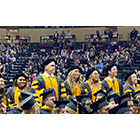The Kansas City University of Medicine and Biosciences (KCU), the largest medical school in Missouri and one of the oldest osteopathic medical schools in the country, signed a partnership agreement today at 11 a.m. with Missouri Southern State University (MSSU), a state-supported university located in Joplin, Missouri. Through this partnership, titled, “Advanced Medical Acceptance Program”, up to 25 MSSU students will be admitted to the KCU College of Osteopathic Medicine (COM) annually following the successful completion of MSSU curriculum. The students are chosen through a joint selection process by both universities at the beginning of their first semester at MSSU. The following area legislators attended the signing:
- Senator Ron Richard
- Representative Tom Flanigan
- Representative Bill Lant
- Representative Charlie Davis
- Representative Bill Reiboldt
KCU and MSSU senior administrators agree this collaboration will foster student success at both institutions. The KCU Joplin campus, which will matriculate its first class of students in 2017, allows the University to continue educating high-quality doctors, specifically within the primary care specialty.
“This unique partnership with Missouri Southern State University guarantees students acceptance into medical school following their high school graduation, paving a bright future for primary care in Joplin, Missouri,” said Marc B. Hahn, DO, president and chief executive officer of KCU. “Through this effort, we are not only excited about developing this pathway for local students into medical school, but recognize that together we can positively impact the access to medical care for Joplin and rural Missouri.”
“This partnership allows us to come up with innovative curricular ideas to ensure our students are in the best possible position to succeed,” said Dr. Paula Carson, provost and vice president for academic affairs at MSSU. “We can start preparing them for what medical school will be like. We’ll have a rigorous curriculum and non-traditional scheduling of courses that will better resemble the calendar and schedule of medical education.”
_20230418161228_0.jpg?w=140&h=140)

